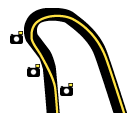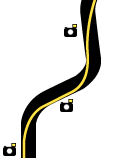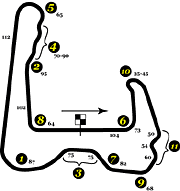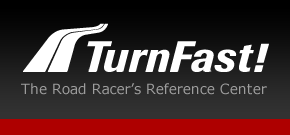Article Topics:
- Overview
- Intro to Racing
- Driving Technique
- Practice Sessions
- Driver’s Gear
- Vehicle Safety
- Handling
- Brakes
- Power
- Tools
TurnFast
recommends
these books:
Articles about Practice Sessions
Prioritizing Track Segments
To maximize your performance at the track, you need to have an organized plan for practicing and determining the car's handling setup.
Before you even take to the track, you should study a map of the track for two areas of preparation: first, to plan what you expect to be the optimum driving line, second, to prioritize the track's corners for optimizing the car's handling setup.
Planning and Practicing the Driving Line
Much as we analyzed a few track segments in the Cornering article of Driving Techniques section, you should analyze the layout of the track you're driving at. Pre-plan for those corner sets where the first corners cannot be driven with a classical racing line in order to maximize the speed of the last corner. Look for where early apexes, or less than full track-out might be necessary to better set up a following corner.
When taking the car out on the first session, the first several laps are mostly for mechanical "shakedown." Driven at about 80% maximum speed, the purpose is to be sure the car mechanically feels good--the handling is roughly at a good starting point (no major oversteer, understeer, etc.), there's no overheating, the brakes feel firm, etc. Second, the tires and brakes need to warmed up to reach their performance potential.
After the shakedown laps, the rest of the session is a collection of reconnaissance laps. Driven at perhaps 85-95% of maximum speed, the driver needs to first become familiar with the track layout. During these laps the driver will:
- refine the optimum driving line from his initial pre-plan (it may need further refinement with a final increase in speed),
- identify reference points for braking, turn-in, apex, and exit points, and
- note track features which can upset the car in braking zones and corners (bumps, ruts, slick patches, etc.)
- make initial notes as to the car's handling characteristics, and which corners may require major adjustments
Prioritizing Corners and Segments
Each turn on the track is not equally important. When practicing and tuning the car's handling, certain portions of the track will be more important to make sure the car can perform at its peak potential. Optimizing your car's overall performance includes prioritizing which segments to maximize performance for, and which segments you'll accept non-optimum performance in if you have to.
It has been typically said that there are only three types of corners:
- corners that open up to long straights,
- corners that open up to short straights, and
- corners that open up to another corner.
Typically corners that open up to long straights are considered the most important because the car spends most its time on the straights, and maximizing the top speed at the end of a straight ultimately provides the best passing opportunities.
As we have looked at in the Cornering article of Driving Techniques section, corners that lead to other corners are taken at less than the optimum classic line in order to be sure the last corner (the one leading to the straight) is optimized. This is the idea of prioritizing put into practice. It is more important to take the last corner as fast as possible, and not the first or middle corners of a series.
In addition to this priority set, we must look at the speeds of the corners involved. The high speed corners are more important than the slower ones. This is due to two factors: first high speed corners are usually long which means the car spends more time in them than in slower and shorter corners. Secondly, the car cannot accelerate through or out of a high speed corner as quickly as it can a slower corner. It is harder to make up for lost speed when the car is at high speeds than at slow speeds. If the driver's line or the car's handling is below optimum, more time will be lost in a 100 mph corner that should be 102 mph, than in a corner driven at 58 instead of 60 mph.
For example, let's compare two track segments. The first features a long high speed turn leading onto a long straight that takes 35 seconds to drive through, and that's 30% of the lap time. The second is a series of 3 short bends that make up the esses section which takes 8 second to drive through and ends up with a short braking zone for a right turn.
It is far more important to make sure that the driver's line and the car's handling setup are optimized for the first segment. First, the car spends more time there. Second, it is important to maximize the corner speed leading onto the straight to maximize the top speed on the straight. The second segment is shorter, but it also connects to a short braking zone. There is not much time to be gained, so it is a lower priority to optimize.
This type of analysis has to be applied to the whole track. Each turn and segment must be prioritized. A segment can be a series of corners, or may be a single corner if it is preceded or followed by a major straight, or is a high speed carousel.
Read Next Article (Practice Sessions Intro)
The Driving Line
Not all corners can be taken on the classical racing line. Sets of corners sometimes require a different approach to maximize the exit speed of the last corner. Click each illustration below. A larger illustration will be shown, the fastest line indicated, and some possible lines you might be tempted to believe are better. This type of pre-analysis should be done by studying a track map before going on to the track. The first run session should be used to determine the general racing line. Subsequent sessions can be used to fine tune corner reference points as your speed increases.


Prioritizing corners
Not all corners are equally important to practice or fine tune the car's handling for. Using a track layout, you should prioritize the corners. On a new track, once you've made a first run, you can fine tune the priority list depending on which corners are good passing zones.

